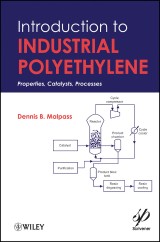Details

Introduction to Industrial Polyethylene
Properties, Catalysts, and ProcessesWiley-Scrivener, Band 19 1. Aufl.
|
92,99 € |
|
| Verlag: | Wiley |
| Format: | |
| Veröffentl.: | 16.07.2010 |
| ISBN/EAN: | 9780470900451 |
| Sprache: | englisch |
| Anzahl Seiten: | 156 |
DRM-geschütztes eBook, Sie benötigen z.B. Adobe Digital Editions und eine Adobe ID zum Lesen.
Beschreibungen
Demystifies the largest volume manmade synthetic polymer by distillingthe fundamentals of what polyethylene is, how it's made and processed,and what happens to it after its useful life is over. <p><b>Endorsement for <i>Introduction to Industrial Polyethylene</i></b></p> <p>"I found this to be a straightforward, easy-to-read, and useful introductory text on polyethylene, which will be helpful for chemists, engineers, and students who need to learn more about this complex topic. The author is a senior polyethylene specialist and I believe we can all benefit from his distillation of knowledge and insight to quickly grasp the key learnings."<br /> —<b>R.E. King III</b>; Ciba Corporation (part of the BASF group)</p> <p>Jargon used in industrial polyethylene technology can often be bewildering to newcomers. <i>Introduction to Industrial Polyethylene</i> educates readers on terminology commonly used in the industry and demystifies the chemistry of catalysts and cocatalysts employed in the manufacture of polyethylene.</p> <p>This concise primer reviews the history of polyethylene and introduces basic features and nomenclatures for this versatile polymer. Catalysts and cocatalysts crucial to the production of polyethylene are discussed in the first few chapters. Latter chapters provide an introduction to the processes used to manufacture polyethylene and discuss matters related to downstream applications of polyethylene such as rheology, additives, environmental issues, etc.</p> <p>Providing industrial chemists and engineers a valuable reference tool that covers fundamental features of polyethylene technology, <i>Introduction to Industrial Polyethylene</i>:</p> <ul> <li> <p>Identifies the fundamental types of polyethylene and how they differ.</p> </li> <li> <p>Lists markets, key fabrication methods, and the major producers of polyethylene.</p> </li> <li> <p>Provides biodegradable alternatives to polyethylene.</p> </li> <li> <p>Describes the processes used in the manufacture of polyethylene.</p> </li> <li> <p>Includes a thorough glossary, providing definitions of acronyms and abbreviations and also defines terms commonly used in discussions of production and properties of polyethylene.</p> </li> <li> <p>Concludes with the future of industrial polyethylene.</p> </li> </ul>
<p>Preface ix</p> <p>List of Tables xiii</p> <p>List of Figures xv</p> <p>Chapter 1 Introduction to Polymers of Ethylene 1</p> <p>Chapter 2 Free Radical Polymerization of Ethylene 23</p> <p>Chapter 3 Ziegler-Natta Catalysts 33</p> <p>Chapter 4 Metal Alkyls in Polyethylene Catalyst Systems 45</p> <p>Chapter 5 Chromium Catalysts 61</p> <p>Chapter 6 Single Site Catalysts 71</p> <p>Chapter 7 An Overview of Industrial Polyethylene Processes 85</p> <p>Chapter 8 Downstream Aspects of Polyethylene 99</p> <p>Glossary 117</p> <p>Trade Name Index 125</p> <p>Index 127</p>
"This concise primer reviews the history of polyethylene and introduces basic features and nomenclatures for this versatile polymer." (Forbes.com, 1 November 2010)
<b>Dennis B. Malpass</b> studied chemistry at Tulane University in New Orleans, LA and received a BS in 1966. He then attended graduate school at the University of Tennessee in Knoxville, TN and studied main group organometallic chemistry receiving his Ph.D. in 1970. His industrial career spanned 33 years working on synthesis, characterization and applications of metal alkyls, especially aluminum alkyls in Ziegler-Natta polymerization of olefins. His work included development of viable commercial processes for trimethylaluminum, a crucial raw material for many single site catalyst systems. Dr. Malpass was also codiscoverer of n-butylethylmagnesium in 1978, still employed today to produce catalysts used in the manufacture of many millions of tons of polyethylene worldwide. Dr. Malpass has more than 70 patents and publications. He retired in 2003 and now consults in the polyolefins industry. He also teaches organic chemistry and is an instructor for continuing education courses for SPE and ACS.
Demystifies the largest volume manmade synthetic polymer by distillingthe fundamentals of what polyethylene is, how it's made and processed,and what happens to it after its useful life is over. <p><b>Endorsement for <i>Introduction to Industrial Polyethylene</i></b></p> <p>"I found this to be a straightforward, easy-to-read, and useful introductory text on polyethylene, which will be helpful for chemists, engineers, and students who need to learn more about this complex topic. The author is a senior polyethylene specialist and I believe we can all benefit from his distillation of knowledge and insight to quickly grasp the key learnings."<br /> —<b>R.E. King III</b>; Ciba Corporation (part of the BASF group)</p> <p>Jargon used in industrial polyethylene technology can often be bewildering to newcomers. <i>Introduction to Industrial Polyethylene</i> educates readers on terminology commonly used in the industry and demystifies the chemistry of catalysts and cocatalysts employed in the manufacture of polyethylene.</p> <p>This concise primer reviews the history of polyethylene and introduces basic features and nomenclatures for this versatile polymer. Catalysts and cocatalysts crucial to the production of polyethylene are discussed in the first few chapters. Latter chapters provide an introduction to the processes used to manufacture polyethylene and discuss matters related to downstream applications of polyethylene such as rheology, additives, environmental issues, etc.</p> <p>Providing industrial chemists and engineers a valuable reference tool that covers fundamental features of polyethylene technology, <i>Introduction to Industrial Polyethylene</i>:</p> <ul> <li> <p>Identifies the fundamental types of polyethylene and how they differ.</p> </li> <li> <p>Lists markets, key fabrication methods, and the major producers of polyethylene.</p> </li> <li> <p>Provides biodegradable alternatives to polyethylene.</p> </li> <li> <p>Describes the processes used in the manufacture of polyethylene.</p> </li> <li> <p>Includes a thorough glossary, providing definitions of acronyms and abbreviations and also defines terms commonly used in discussions of production and properties of polyethylene.</p> </li> <li> <p>Concludes with the future of industrial polyethylene.</p> </li> </ul>


















